Characteristics and Influencing Factors of Spatial Differentiation of Urban Black and Odorous Waters in China
Abstract
:1. Introduction
2. Study Methods and Data Sources
2.1. Data Sources and Indicator Selection
2.1.1. Data on Urban Black and Odorous Waters in China
2.1.2. Data on Social and Economic Development
2.1.3. Data of Basic Geographic Information of Chinese Map
2.2. Study Methods
2.2.1. Nearest Neighbor Index
2.2.2. Kernel Density Estimation
2.2.3. Spatial Correlation Analysis
2.2.4. Geodetector Method
3. Results
3.1. Spatial Differentiation Characteristics
3.1.1. Regional Distribution Characteristics
3.1.2. Spatial Type Characteristics
3.1.3. Spatial Density Characteristics
3.1.4. Spatial Correlation Characteristics
3.2. Factors Influencing Spatial Characteristics
4. Discussion
4.1. Spatial Characteristics Promote Top-Level System Design for the Treatment of Black and Odorous Waters
4.2. Influencing Factors Are an Important Point of Breakthrough in Treating Black and Odorous Waters
4.3. Limitations of the Study
5. Conclusions
- (1)
- Urban black and odorous waters varied in amount and agglomerated in type. The number of urban black and odorous waters showed differences across the various local areas, regions, and urban agglomerations of China. Their spatial distribution was an agglomerated type, with significant agglomeration.
- (2)
- Urban black and odorous waters showed significant kernel density and spatially-related features. Concerning the spatial distribution of urban black and odorous waters in China, the kernel density showed two independent single-kernel centers, with ribbon-like and sporadic distribution of subcenters. Different types of black and odorous waters had significantly different kernel density centers and kernel density values. The spatial correlation characteristics showed particularity. Except for severely affected waters and those in ponds lacking spatial correlation, all the remaining types of waters were spatially positively correlated. The cold and hot spots showed a gradient distribution pattern of cold in southwest and hot in central-east, with relatively high stability and continuity and considerable polarization between the east and west.
- (3)
- The contribution of the factors to the characteristics of urban black and odorous waters varies according to the division of areas. On a national scale, the geodetection of spatial distribution characteristics revealed a few core influencing factors, which had relatively weak contributions. After different divisions of the study areas, the detection results highlighted the spatial differences in the contribution of influencing factors to the spatial distribution characteristics and the matching of important core influencing factors.
- (4)
- The spatial distribution characteristics of urban black and odorous waters has prominent contributing factors. The important core factors influencing the spatial distribution characteristics of black and odorous waters in China were total wastewater discharge, length of urban drainage pipelines, municipal solid waste collection, daily sewage treatment capacity, and investment in industrial pollution treatment of wastewater. The detection factors influence the formation and development of urban black and odorous waters, while providing a path for the protection and treatment of urban black and odorous waters in China.
- (5)
- The research results can be used to help the Chinese government to introduce and implement measures to treat the pollution of black and odorous waters. First of all, each city should establish the information database of urban black and odorous waters and make sure that the mayor is the first responsible person for the treatment. In addition, a one-year special campaign will be carried out in the areas of high kernel density and hot spots in urban black and odorous waters and gradually promoted to the whole country. Besides, the core influencing factors of urban black and odorous waters are checked and optimized or eliminated. What is more, the government will regularly announce the treatment of urban black and odorous waters to the public. Finally, researchers are encouraged to carry out more scientific research on urban black and odorous waters.
Author Contributions
Funding
Conflicts of Interest
References
- Wu, G.; Miao, Z.; Shao, S.; Jiang, K.S.; Geng, Y.; Li, D.J.; Liu, H.M. Evaluating the construction efficiencies of urban wastewater transportation and treatment capacity: Evidence from 70 megacities in China. Resour. Conserv. Recycl. 2018, 128, 373–381. [Google Scholar] [CrossRef]
- Hu, Q.; Li, X.L.; Li, A.J.; Qi, W.K.; Li, X.J.; Yang, X.J. Total emission control policy in China. Environ. Dev. 2018, 25, 126–129. [Google Scholar] [CrossRef]
- Cai, E.X.; Jing, Y.; Liu, Y.L.; Yin, C.H.; Gao, Y.; Wei, J.Q. Spatial-temporal patterns and driving forces of Ecological-Living-Production land in Hubei province, central China. Sustainability 2018, 10, 66. [Google Scholar] [CrossRef]
- Song, C.; Liu, X.L.; Song, Y.H.; Liu, R.X.; Gao, H.J.; Lu, H.; Peng, J.F. Key blackening and stinking pollutants in Dongsha River of Beijing: Spatial distribution and source identification. J. Environ. Manag. 2017, 200, 335–346. [Google Scholar] [CrossRef] [PubMed]
- Hu, Y.N.; Cheng, H.F. Water pollution during China’s industrial transition. Environ. Dev. 2013, 8, 57–73. [Google Scholar] [CrossRef]
- Jiang, Y. China’s water security: Current status, emerging challenges and future prospects. Environ. Sci. Policy 2015, 54, 106–125. [Google Scholar] [CrossRef]
- Shen, Q.; Zhu, L.; Cao, H.Y. Remote sensing monitoring and screening for urban black and odorous water body: A review. Chin. J. Appl. Ecol. 2017, 8, 3433–3439. [Google Scholar]
- Ministry of Housing and Urban-Rural Development of the People’s Republic of China. Notice on Printing and Distributing the Guidelines for the Remediation of Urban Black and Odorous Waters. Available online: http://www.mohurd.gov.cn/wjfb/201509/t20150911_224828.html (accessed on 10 September 2018).
- The State Council. Action Plan for Prevention and Control of Water Pollution. 2015. Available online: http://www.gov.cn/zhengce/content/2015-04/16/content_9613.htm (accessed on 15 September 2018).
- Anonymous. London sewage and the river thames. Br. Med. J. 1928, 1, 676–677. [Google Scholar]
- Lazaro, T.R. Urban Hydrog; Science Publishers: Ann Arbor, MI, USA, 1979. [Google Scholar]
- Liu, C.; Shen, Q.S.; Zhou, Q.L.; Fan, C.X.; Shao, S.G. Precontrol of algae-induced black blooms through sediment dredging at appropriate depth in a typical eutrophic shallow lake. Ecol. Eng. 2015, 77, 139–145. [Google Scholar] [CrossRef]
- Hishida, Y.; Ashitani, K.; Fujiwara, K. Occurrence of musty odor in the Yodo River. Water Sci. Technol. 1988, 20, 193–196. [Google Scholar] [CrossRef]
- Chen, J.; Xie, P.; Ma, Z.M.; Niu, Y.; Tao, M.; Deng, X.W.; Wang, Q. A systematic study on spatial and seasonal patterns of eight taste and odor compounds with relation to various biotic and abiotic parameters in Gonghu Bay of Lake Taihu, China. Sci. Total Environ. 2010, 409, 314–325. [Google Scholar] [CrossRef] [PubMed] [Green Version]
- Gao, J.H.; Jia, J.J.; Kettner, A.J.; Xing, F.; Wang, Y.P.; Xu, X.N.; Yang, Y.; Zou, X.Q.; Gao, S.; Qi, S.H.; et al. Changes in water and sediment exchange between the Changjiang River and Poyang Lake under natural and anthropogenic conditions, China. Sci. Total Environ. 2014, 481, 542–553. [Google Scholar] [CrossRef] [PubMed]
- Sheng, Y.Q.; Qu, Y.X.; Ding, C.F.; Sun, Q.Y.; Mortimer, R.J.G. A combined application of different engineering and biological techniques to remediate a heavily polluted river. Ecol. Eng. 2013, 57, 1–7. [Google Scholar] [CrossRef] [Green Version]
- Sánchez-Morales, M.; Sabater, F.; Muñoz, I. Effects of urban wastewater on hyporheic habitat and invertebrates in Mediterranean streams. Sci. Total Environ. 2018, 642, 937–945. [Google Scholar] [CrossRef] [PubMed]
- Wang, W.F.; Ndungu, A.W.; Li, Z.; Wang, J. Microplastics pollution in inland freshwaters of China: A case study in urban surface waters of Wuhan, China. Sci. Total Environ. 2017, 575, 1369–1374. [Google Scholar] [CrossRef] [PubMed]
- Huang, F.; Wang, X.Q.; Lou, L.P.; Zhou, Z.Q.; Wu, J.P. Spatial variation and source apportionment of water pollution in Qiantang River (China) using statistical techniques. Water Res. 2010, 44, 1562–1572. [Google Scholar] [CrossRef] [PubMed]
- Wang, Q.; Yang, Z.M. Industrial water pollution, water environment treatment, and health risks in China. Environ. Pollut. 2016, 218, 358–365. [Google Scholar] [CrossRef] [PubMed]
- Lai, W.Y. Pesticide use and health outcomes: Evidence from agricultural water pollution in China. J. Environ. Econ. Manag. 2017, 86, 93–120. [Google Scholar] [CrossRef]
- Tian, X.L.; Guo, Q.G.; Han, C.; Ahmad, N.J. Different extent of environmental information disclosure across chinese cities: Contributing factors and correlation with local pollution. Glob. Environ. Chang. 2016, 39, 244–257. [Google Scholar] [CrossRef]
- Kumar, P.; Saroj, D.P. Water-energy-pollution nexus for growing cities. Urban Clim. 2014, 10, 846–853. [Google Scholar] [CrossRef]
- Sado-Inamura, Y.; Fukushi, K. Considering water quality of urban rivers from the perspectives of unpleasant odor. Sustainability 2018, 10, 650. [Google Scholar] [CrossRef]
- Smith, V.H.; Jonathan, S.D.; Frank, D.J. Managing taste and odor problems in a eutrophic drinking water reservoir. J. Lake Reserv. Manag. 2002, 18, 319–323. [Google Scholar] [CrossRef]
- Sugiura, N.; Utsumi, M.; Wei, B. Assessment for the complicated occurrence of nuisance odours from phytoplankton and environmental factors in a eutrophic lake. Lakes Reserv. Res. Manag. 2004, 9, 195–201. [Google Scholar] [CrossRef]
- Dzialowski, A.R.; Smith, V.H.; Huggins, D.G. Development of predictive models for geosmin-related taste and odor in Kansas, USA, drinking water reservoirs. Water Res. 2009, 43, 2829–2840. [Google Scholar] [CrossRef] [PubMed]
- Panahi, Y.; Mellatyar, H.; Farshbaf, M.; Sabet, Z.B.; Fattahi, T.; Akbarzadehe, A. Biotechnological applications of nanomaterials for air pollution and water/wastewater treatment. Mater. Today Proc. 2018, 5, 15550–15558. [Google Scholar] [CrossRef]
- Zhang, X.H.; Xiang, N.; Wang, W.L.; Liao, W.J.; Yang, X.D.; Shui, W.; Wu, J.; Deng, S.H. An emergy evaluation of the sewage sludge treatment system with earthworm compositing technology in Chengdu, China. Ecol. Eng. 2018, 110, 8–17. [Google Scholar] [CrossRef]
- Sandoval-Herazo, L.C.; Alvarado-Lassman, A.; Marín-Muñiz, J.L.; Méndez-Contreras, J.M.; Zamora-Castro, S.A. Effects of the use of ornamental plants and different substrates in the removal of wastewater pollutants through microcosms of constructed wetlands. Sustainability 2018, 10, 1594. [Google Scholar] [CrossRef]
- Huang, Q.D.; Xu, J.J.; Wei, Y.P. Clan in transition: Societal changes of villages in China from the perspective of water pollution. Sustainability 2018, 10, 150. [Google Scholar] [CrossRef]
- Wang, T.; Shi, F.; Zhang, Q.; Qian, X.P.; Hashimoto, S.J. Exploring material stock efficiency of municipal water and sewage infrastructures in China. J. Clean. Prod. 2018, 181, 498–507. [Google Scholar] [CrossRef]
- Udimal, T.B.; Jincai, Z.; Ayamba, E.C.; Owusu, S.M. China’s water situation; the supply of water and the pattern of its usage. Int. J. Sustain. Built Environ. 2017, 6, 491–500. [Google Scholar] [CrossRef]
- Yang, R.; Xu, Q.; Long, H.L. Spatial distribution characteristics and optimized reconstruction analysis of China’s rural settlements during the process of rapid urbanization. J. Rural Stud. 2016, 47, 413–424. [Google Scholar] [CrossRef] [Green Version]
- Cai, X.C.; Wu, Z.F.; Cheng, J. Using kernel density estimation to assess the spatial pattern of road density and its impact on landscape fragmentation. Int. J. Geogr. Inf. Sci. 2013, 27, 222–230. [Google Scholar] [CrossRef] [Green Version]
- Bailey, T.; Gatrell, A. Interactive Spatial Data Analysis; Longman Harlow: Essex, UK, 1995. [Google Scholar]
- Sridharan, S.; Tunstall, H.; Lawder, R. An exploratory spatial data analysis approach to understanding the relationship between deprivation and mortality in Scotland. Soc. Sci. Med. 2007, 65, 1942–1952. [Google Scholar] [CrossRef] [PubMed]
- Cliff, A.D.; Ord, J.K. Spatial and temporal analysis: Autocorrelation in space and time. In Quantitative Geography: A British View; Pion: London, UK, 1981; pp. 127–144. [Google Scholar]
- Anselin, L. Local indicators of spatial association-LISA. Geogr. Anal. 1995, 27, 93–115. [Google Scholar] [CrossRef]
- Xu, X.; Zhao, Y.; Zhang, X.L.; Xia, S.Y. Identifying the impacts of social, economic, and environmental factors on population aging in the Yangtze River Delta using the geographical detector technique. Sustainability 2018, 10, 1528. [Google Scholar] [CrossRef]
- Getis, A.; Ord, J.K. Local spatial statistics: An overview. In Spatial Analysis: Modelling in a GIS Environment; Longley, P., Batty, M., Eds.; Geo Information International: Cambridge, UK, 1996; pp. 261–271. [Google Scholar]
- Wang, J.F.; Li, X.H.; George, C.; Liao, Y.-L.; Zhang, T.; Gu, X.; Zheng, X.-Y. Geographical detectors-based health risk assessment and its application in the neural tube defects study of the Heshun region, China. Int. J. Geogr. Inf. Sci. 2010, 24, 107–127. [Google Scholar] [CrossRef]
- Wang, J.F.; Hu, Y. Environmental health risk detection with GeogDetector. Environ. Model. Softw. 2012, 33, 114–115. [Google Scholar] [CrossRef]
- Wang, J.F.; Zhang, T.L.; Fu, B.J. A measure of spatial stratified heterogeneity. Ecol. Indic. 2016, 67, 250–256. [Google Scholar] [CrossRef] [Green Version]
- Hu, Y.; Wang, J.F.; Li, X.H.; Ren, D.; Zhu, J. Geographical Detector-based risk assessment of the Under-five mortality in the 2008 Wenchuan earthquake, China. PLoS ONE 2011, 6, e21427. [Google Scholar] [CrossRef]
- Ye, Y.; Qi, Q.; Jiang, L.; Zhang, A. Impact factors of grain output from farms in Heilongjiang reclamation area based on geographical detector. Geogr. Res. 2018, 37, 171–182. (In Chinese) [Google Scholar]
- Song, T.; Cheng, Y.; Liu, W.D.; Liu, H. The spatial disparity and impact mechanism of geo-economy in the border areas of China. Acta Geogr. Sin. 2017, 72, 1731–1745. (In Chinese) [Google Scholar]
- Liu, Q.Q.; Wang, S.J.; Zhang, W.Z.; Li, J.M. Income distribution and environmental quality in China: A spatial econometric perspective. J. Clean. Prod. 2018, 205, 14–26. [Google Scholar] [CrossRef]
- Lu, S.B.; Gao, X.R.; Li, W.; Jiang, S.L.; Huang, L. A study on the spatial and temporal variability of the urban residential water consumption and its influencing factors in the major cities of China. Habitat Int. 2018, 78, 29–40. [Google Scholar] [CrossRef]
- Yu, H.B.; Song, Y.H.; Chang, X.; Gao, H.J.; Peng, J.F. A Scheme for a sustainable urban water environmental system during the urbanization process in China. Engineering 2018, 4, 190–193. [Google Scholar] [CrossRef]
- Zhang, Y.L.; Wu, Y.Y.; Yu, H.; Dong, Z.F.; Zhang, B. Trade-offs in designing water pollution trading policy with multiple objectives: A case study in the Tai Lake Basin, China. Environ. Sci. Policy 2013, 33, 295–307. [Google Scholar] [CrossRef]
- Haque, N. Exploratory analysis of fines for water pollution in Bangladesh. Water Resour. Ind. 2017, 18, 1–8. [Google Scholar] [CrossRef]
- Tang, Y.H.; Miao, X.; Zang, H.Y.; Gao, Y.H. Information disclosure on Hazards from industrial water pollution incidents: Latent resistance and countermeasures in China. Sustainability 2018, 10, 1475. [Google Scholar] [CrossRef]
- Intergovernmental Panel on Climate Change. The Intergovernmental Panel on Climate Change Special Report: Global Warming of 1.5 °C. 2018. Available online: https://www.ipcc.ch/sr15/chapter/summary-for-policy-makers/?tdsourcetag=s_pcqq_aiomsg (accessed on 1 December 2018).
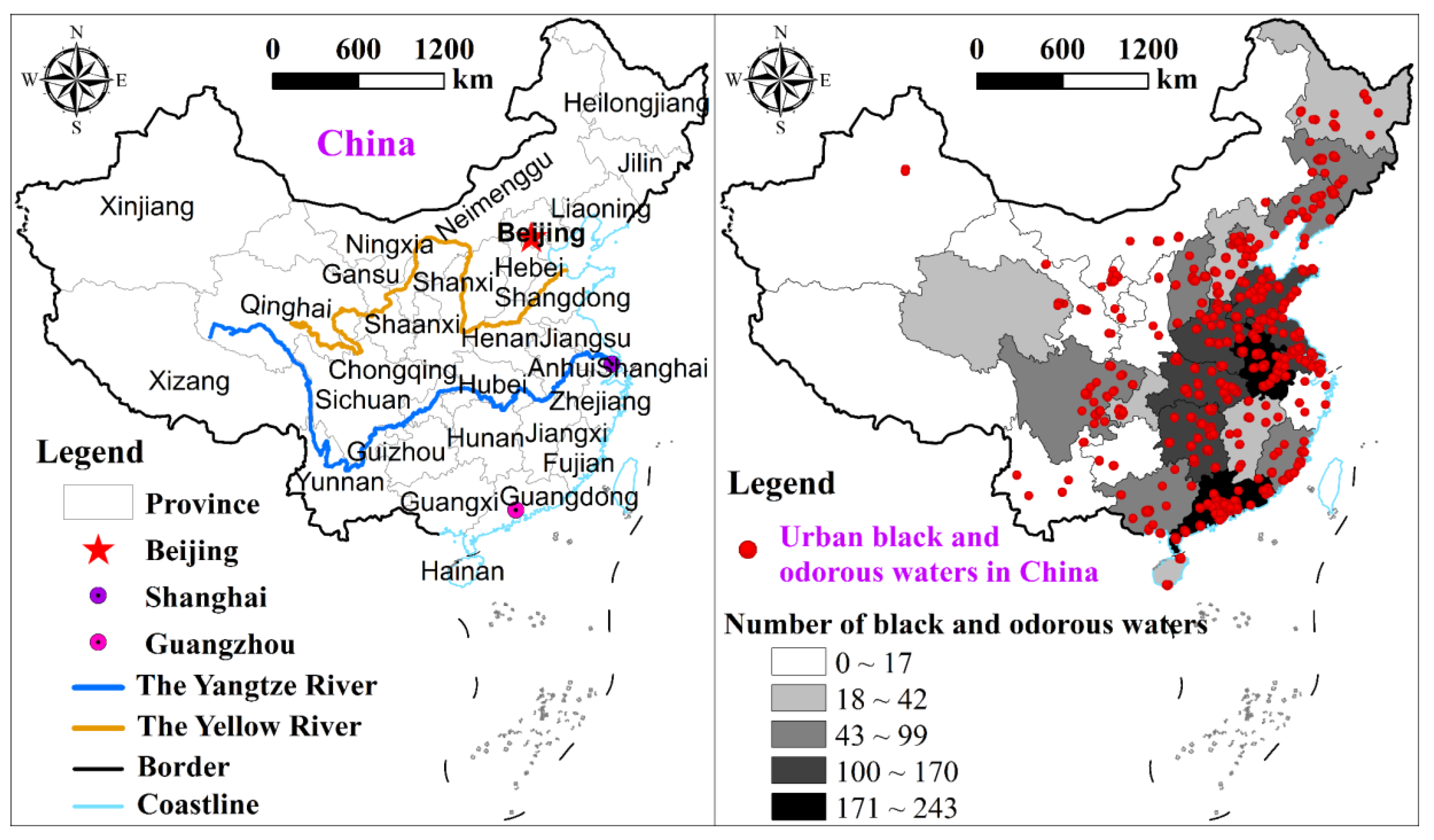
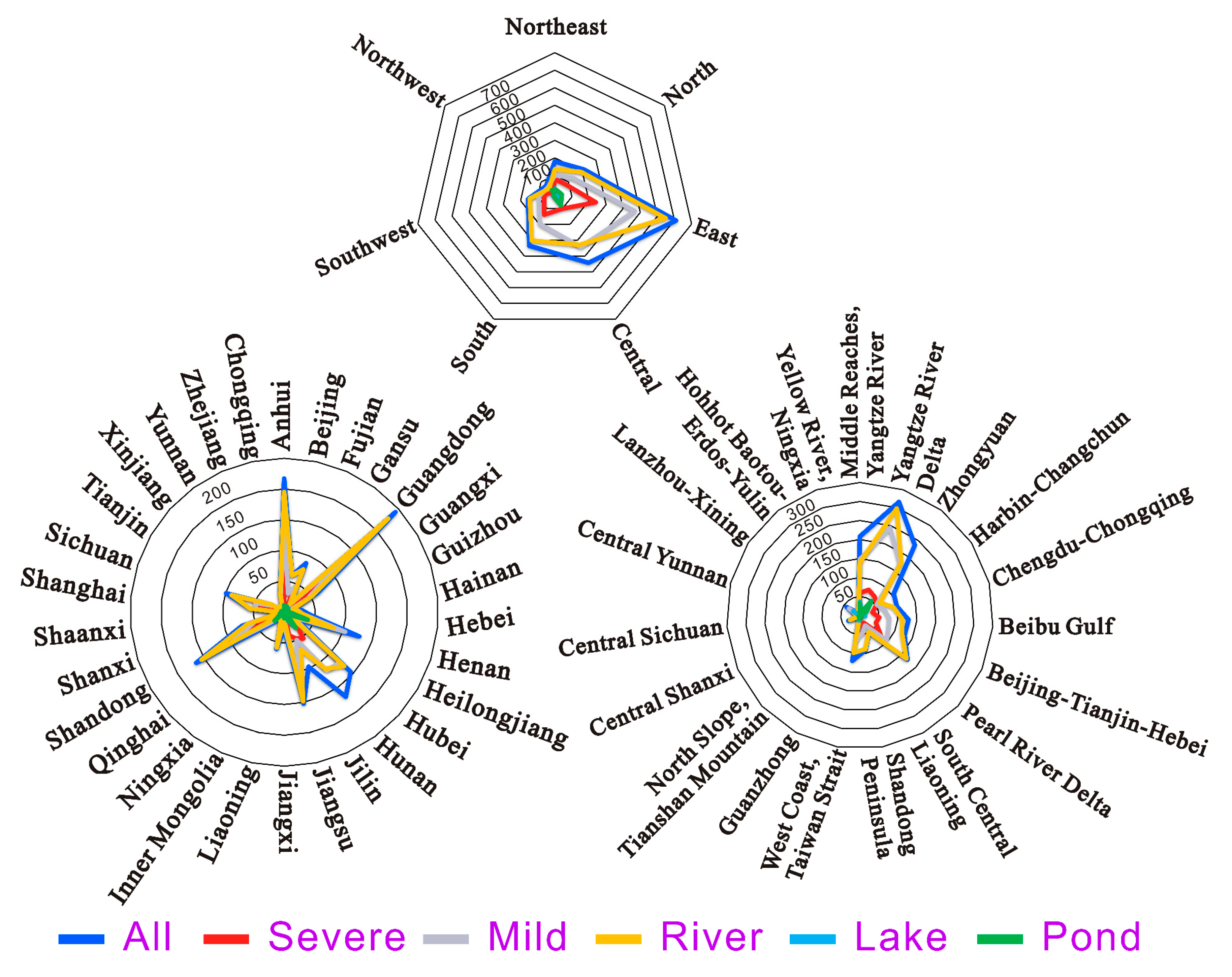
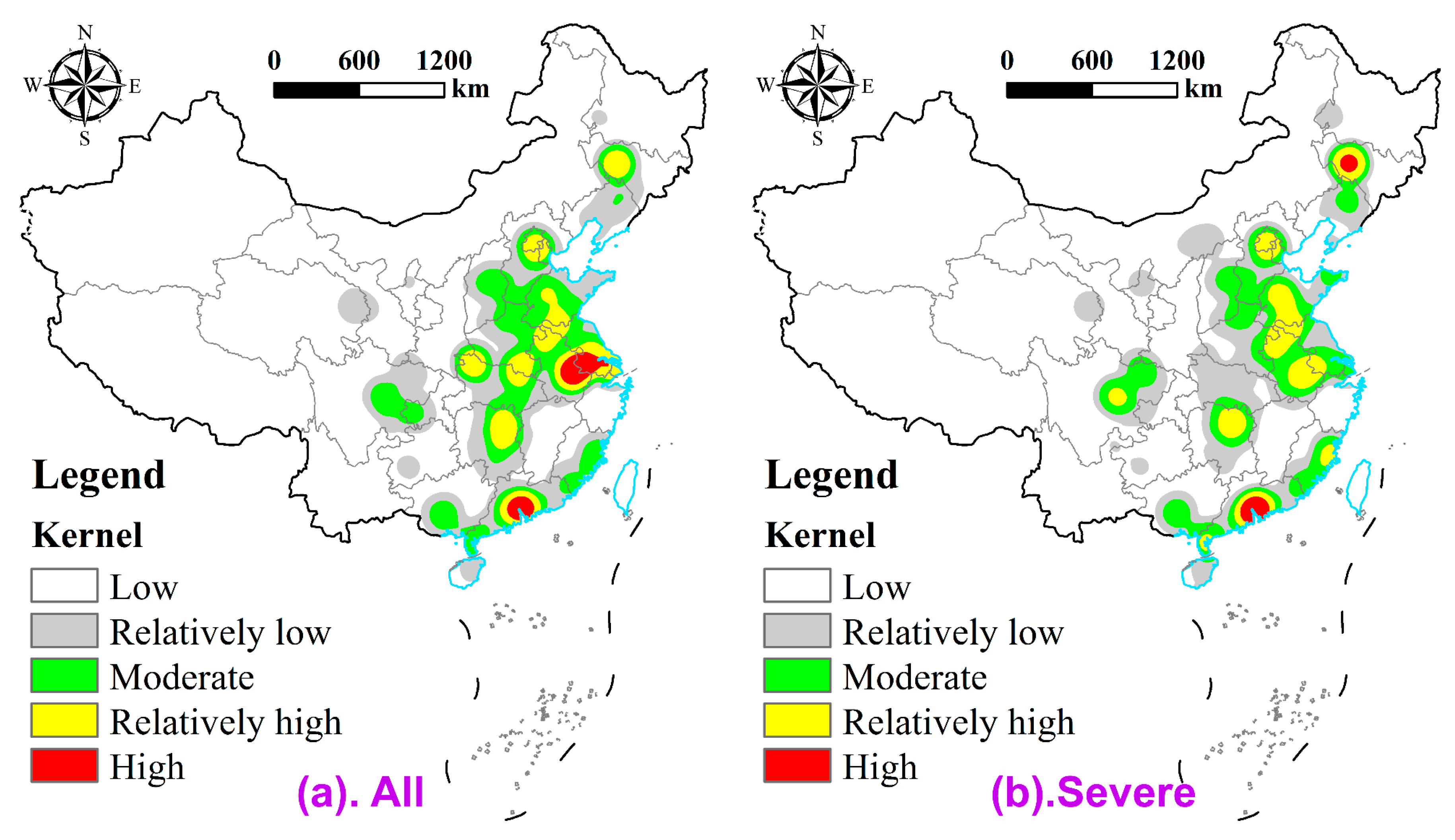
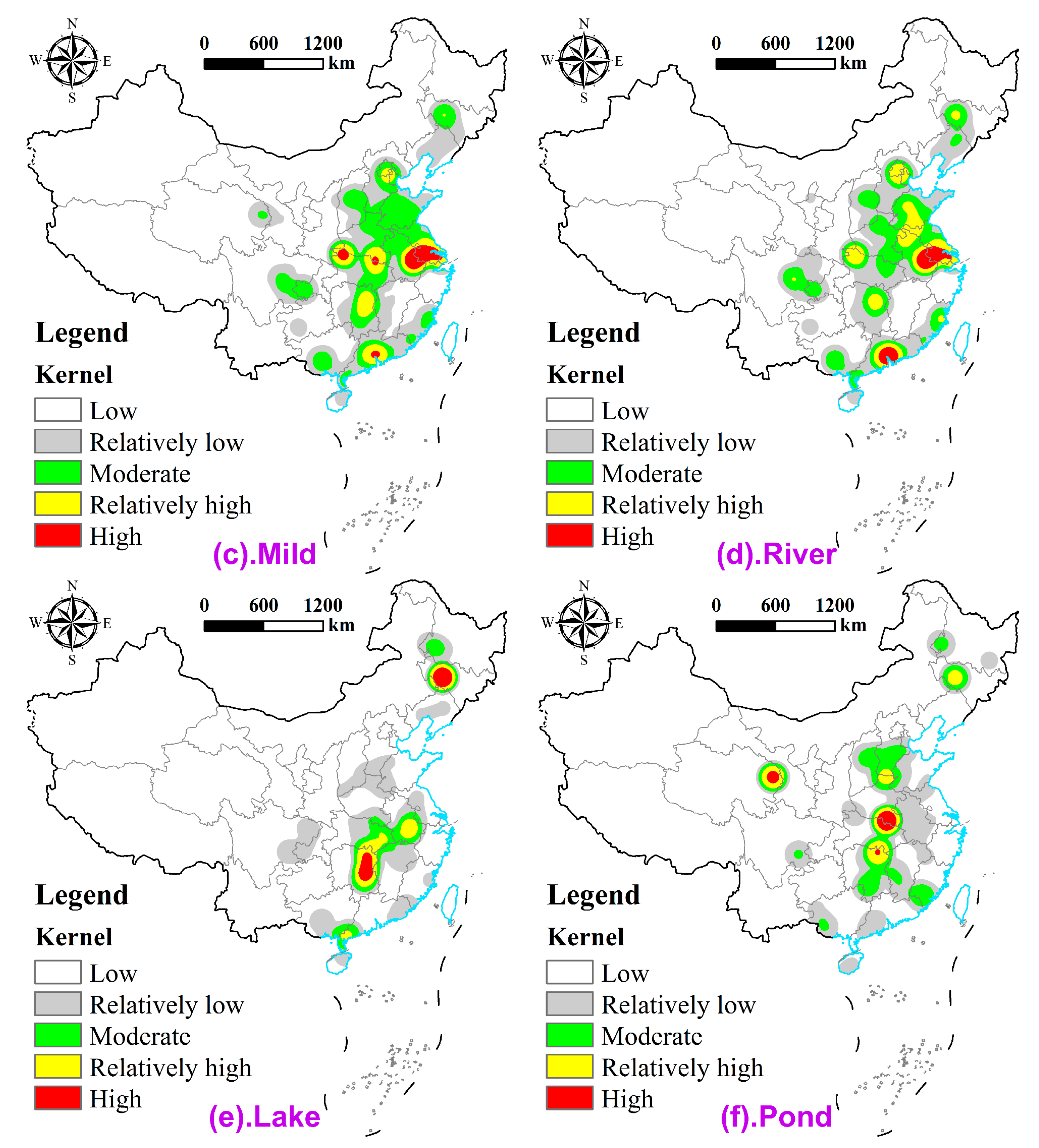
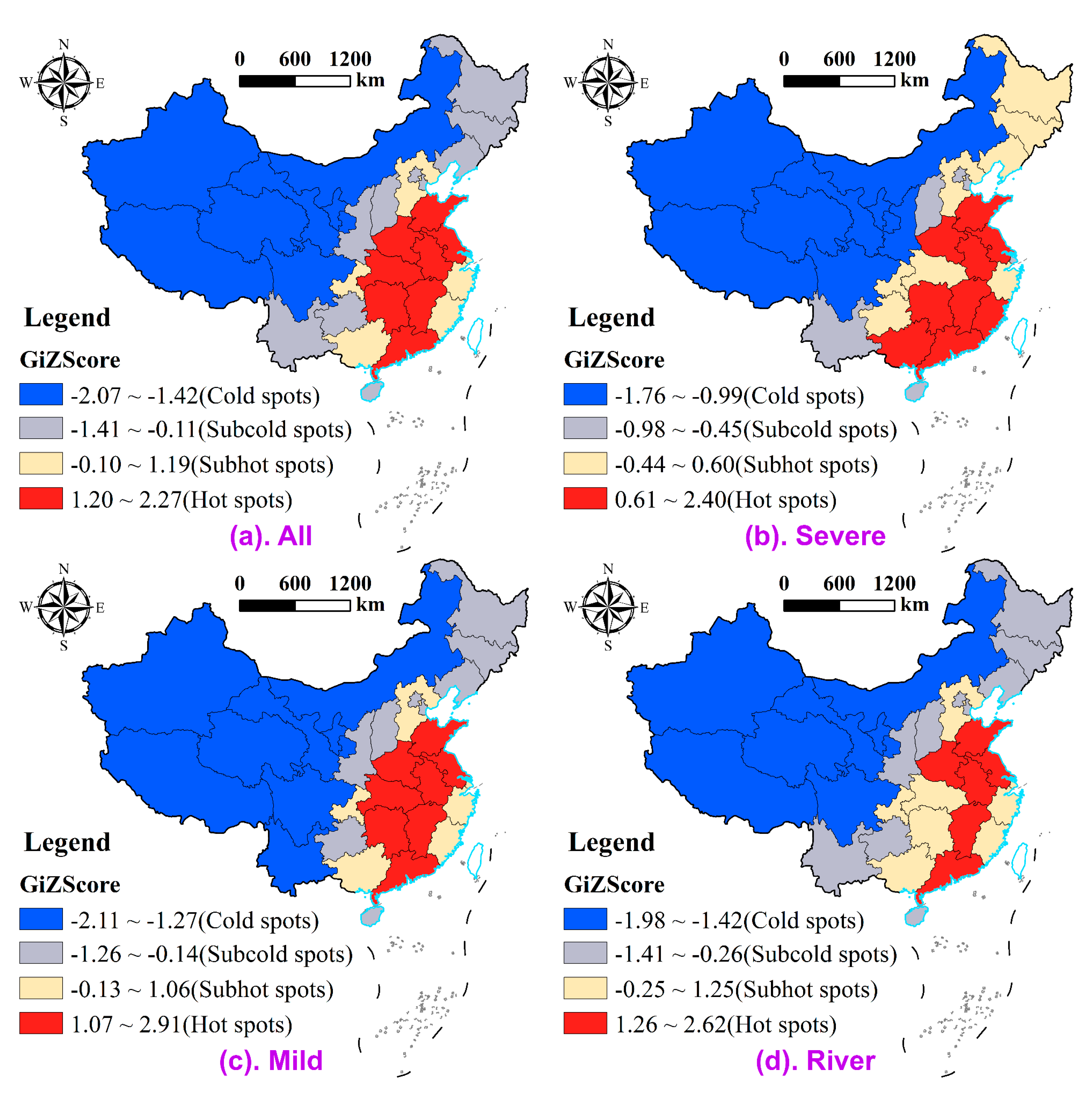
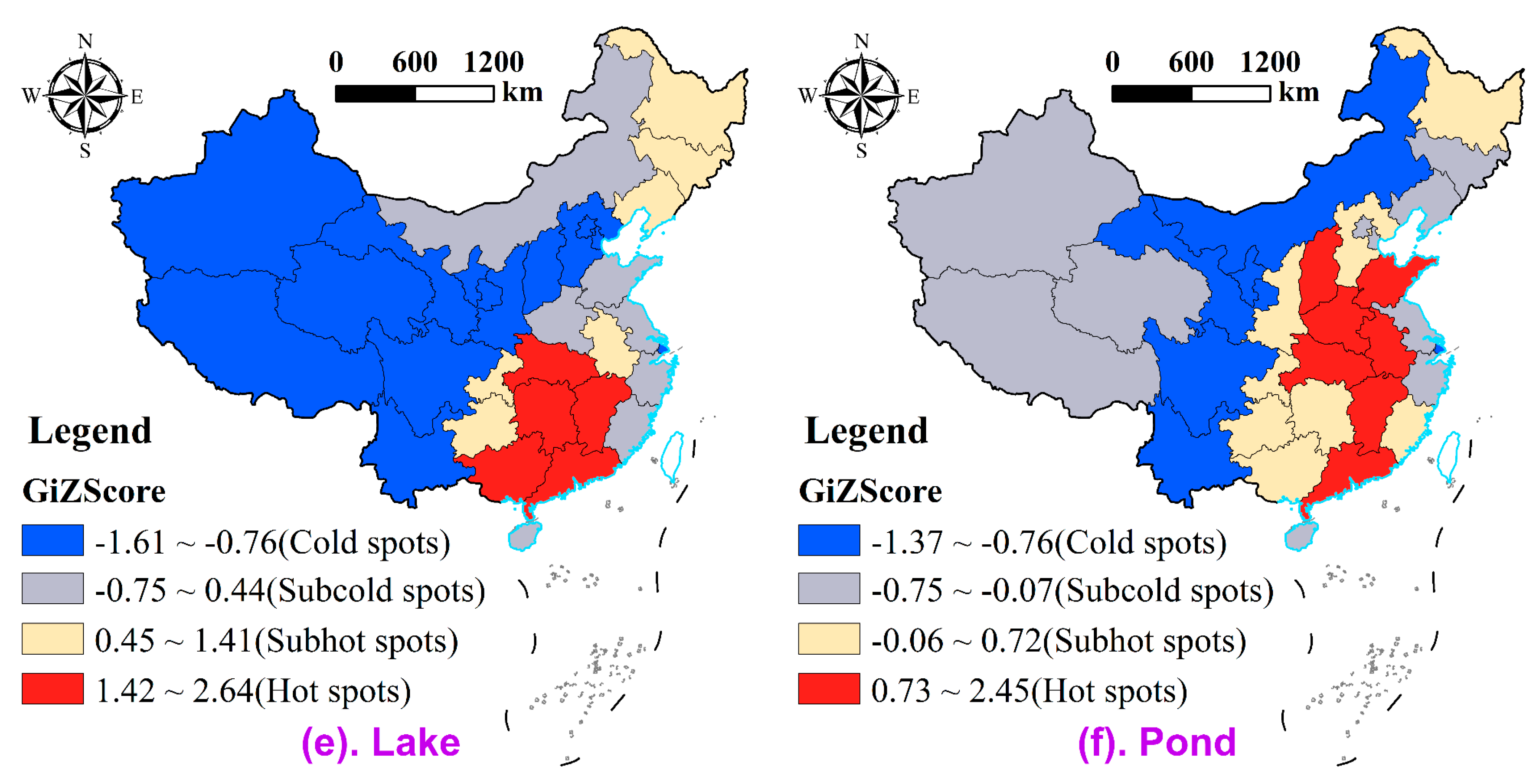
| Detection Factor | Detection Indicator | Unit | Factor Interpretation |
|---|---|---|---|
| X1 | Urban population density | Persons/square kilometer | The population living in a unit area of the city |
| X2 | Per capita gross domestic product (GDP) | Chinese Yuan | The ratio of the total GDP achieved during the accounting period to the resident population within the same range |
| X3 | Per capita water resources | Cubic meters/person | The total amount of surface and ground water formed by precipitation that each person possesses on average during the accounting period in a region. |
| X4 | Per capita water consumption | Cubic meters/person | The average daily gross water consumption by all types of water users, including water loss from transportation |
| X5 | Total wastewater discharge | 10,000 tons | The total amount of water discharged by industry, tertiary industry, and residents’ life |
| X6 | Municipal solid waste collection | 10,000 tons | The amount of municipal solid wastes collected and transported to the treatment plants (sites) and the final disposal sites during the accounting period |
| X7 | Length of urban drainage pipelines | 1000 m | The sum of the lengths of all drainage pipelines (header, trunk, and branch) and the inlet and outlet of connection wells |
| X8 | Daily urban sewage treatment capacity | 10,000 square meters | The designed volume capacity of sewage treatment plants (or sewage treatment devices) for sewage treatment every day and night |
| X9 | Investment in industrial pollution treatment of wastewater | 10,000 Chinese Yuan | The investment implemented during the accounting period for the treatment of wastewater produced by industrial pollution |
| Type | Z Score | |||
|---|---|---|---|---|
| Total | 0.1416 | 5.4406 | 35.6159 | −75.2148 |
| Severe | 0.1442 | 7.0744 | 49.0548 | −43.6546 |
| Mild | 0.1713 | 7.5039 | 43.8034 | −59.0421 |
| In rivers | 0.1645 | 6.3434 | 38.5477 | −67.6384 |
| In lakes | 0.4057 | 40.7569 | 100.4487 | −11.5377 |
| In ponds | 0.2463 | 21.5539 | 87.4984 | −20.5932 |
| Factor | Nationwide | East | Central | West | South | North | ||||||
|---|---|---|---|---|---|---|---|---|---|---|---|---|
| q | p | q | p | q | p | q | p | q | p | q | p | |
| X1 | 0.0297 | 0.6625 | 0.0816 | 0.7637 | 0.1431 | 0.6738 | 0.0578 | 0.8150 | 0.2341 | 0.3513 | 0.1018 | 0.5081 |
| X2 | 0.0346 | 0.7205 | 0.2287 | 0.4304 | 0.1907 | 0.6132 | 0.1626 | 0.5891 | 0.1135 | 0.6917 | 0.0400 | 0.8459 |
| X3 | 0.0355 | 0.3194 | 0.0897 | 0.7873 | 0.3276 | 0.3272 | 0.0713 | 0.4709 | 0.0828 | 0.3172 | 0.0891 | 0.5576 |
| X4 | 0.1177 | 0.1831 | 0.1830 | 0.7537 | 0.3677 | 0.2935 | 0.0775 | 0.7617 | 0.0458 | 0.7768 | 0.1487 | 0.3667 |
| X5 | 0.3402 | 0.4670 | 0.6516 | 0.3129 | 0.4155 | 0.3946 | 0.8886 | 0.0272 | 0.4324 | 0.5698 | 0.5127 | 0.1521 |
| X6 | 0.3683 | 0.3598 | 0.6226 | 0.3560 | 0.3974 | 0.3988 | 0.8850 | 0.0297 | 0.5104 | 0.4074 | 0.2348 | 0.7167 |
| X7 | 0.4189 | 0.0734 | 0.8556 | 0.0057 | 0.4675 | 0.1777 | 0.9073 | 0.0162 | 0.4655 | 0.2605 | 0.5121 | 0.2651 |
| X8 | 0.2690 | 0.3532 | 0.6177 | 0.1690 | 0.5379 | 0.4935 | 0.8849 | 0.0297 | 0.4770 | 0.2350 | 0.3484 | 0.2036 |
| X9 | 0.2952 | 0.2197 | 0.3806 | 0.3927 | 0.4459 | 0.6394 | 0.2854 | 0.4354 | 0.1440 | 0.7658 | 0.3510 | 0.5920 |
© 2018 by the authors. Licensee MDPI, Basel, Switzerland. This article is an open access article distributed under the terms and conditions of the Creative Commons Attribution (CC BY) license (http://creativecommons.org/licenses/by/4.0/).
Share and Cite
Chen, G.; Luo, J.; Zhang, C.; Jiang, L.; Tian, L.; Chen, G. Characteristics and Influencing Factors of Spatial Differentiation of Urban Black and Odorous Waters in China. Sustainability 2018, 10, 4747. https://doi.org/10.3390/su10124747
Chen G, Luo J, Zhang C, Jiang L, Tian L, Chen G. Characteristics and Influencing Factors of Spatial Differentiation of Urban Black and Odorous Waters in China. Sustainability. 2018; 10(12):4747. https://doi.org/10.3390/su10124747
Chicago/Turabian StyleChen, Guolei, Jing Luo, Chunyan Zhang, Liang Jiang, Lingling Tian, and Guangping Chen. 2018. "Characteristics and Influencing Factors of Spatial Differentiation of Urban Black and Odorous Waters in China" Sustainability 10, no. 12: 4747. https://doi.org/10.3390/su10124747
APA StyleChen, G., Luo, J., Zhang, C., Jiang, L., Tian, L., & Chen, G. (2018). Characteristics and Influencing Factors of Spatial Differentiation of Urban Black and Odorous Waters in China. Sustainability, 10(12), 4747. https://doi.org/10.3390/su10124747






